The blue jay Cyanocitta cristata is one of the most common resident birds and visitors at bird feeders here in New England. Have you ever wondered what these common songbirds symbolize? After doing a bit of research, I have discovered that these birds symbolize curiosity, communication, and intelligence. I also discovered that blue jays also represent fearlessness and protection. If you have ever taken the time to really watch these birds in regard to how they interact with one another, these descriptions are pretty accurate. Along with their intelligence, blue jays are also known for their complex social systems that they form through tight family bonds.
One of my favorite times for watching these birds is during the late summer into early fall. I have an abundance of blue jays in the backyard and at the feeders during this time. It is quite fascinating to watch these birds interact with each other. They arrive at the feeders in large groups and take over for a bit during the summer. The other species of birds scatter and give way to the blue jays. I space the feeders out enough, so there is plenty of food for all the species of birds to enjoy. My favorite sight is watching the adults feed the young birds. The adults are very protective of their young. I also get a kick out of the bald blue jays during the month of August. This is a common sight at that time of year and is completely normal. This is simply due to molting and then their baldness will be replaced with feathers. I believe there is an abundance of these bald blue jays in the yard during this time of year because the families of these birds frequently stick together. I will have to get a few photographs of this entertaining event this coming summer.
This past summer, I had to save a blue jay from a sharp-shinned hawk Accipiter striatus attack. I had been working on the computer and I heard a horrible sound coming from outside one of the open windows. It sounded like something was being murdered. Indeed, it was; there was about to be the murder of a blue jay. I ran outside to see what was going on and on the side of the house, a sharp-shinned hawk was in hot pursuit of a blue jay. The closest thing I had at hand were the tomatoes from the garden. I grabbed a green tomato and threw it into the general area of the scuffle and it stunned the hawk enough to let go of the blue jay it had in its beak. The blue jay got away and the hawk had to find a meal elsewhere. These hawks are fierce hunters and that blue jay sure put up a good fight for its life. It sure lived up to its fearless blue jay reputation. I usually don’t like to interfere with nature, but I was in the area to come to the blue jay’s rescue.
The following photographs are a collection that I have taken around the yard and I will share a few interesting facts about this brilliant species of bird.
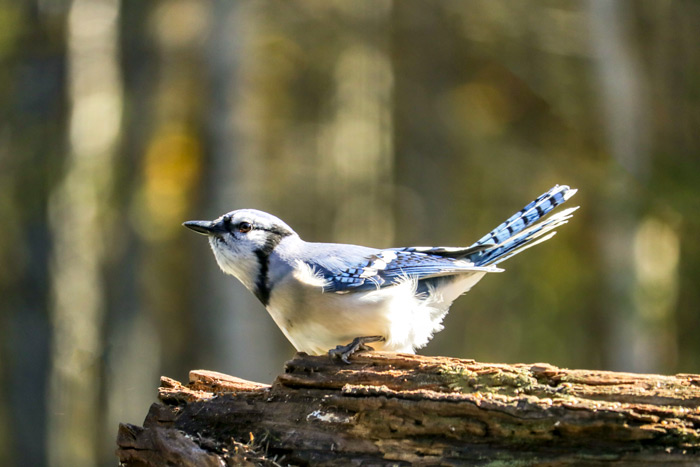
Blue jays are large songbirds with a crest that may be raised or lowered according to the bird’s mood. These birds are between 9 and 12 inches in length. The males and females are almost identical, but the male is slightly larger. Observers may be able to distinguish between the sexes based on behavior.
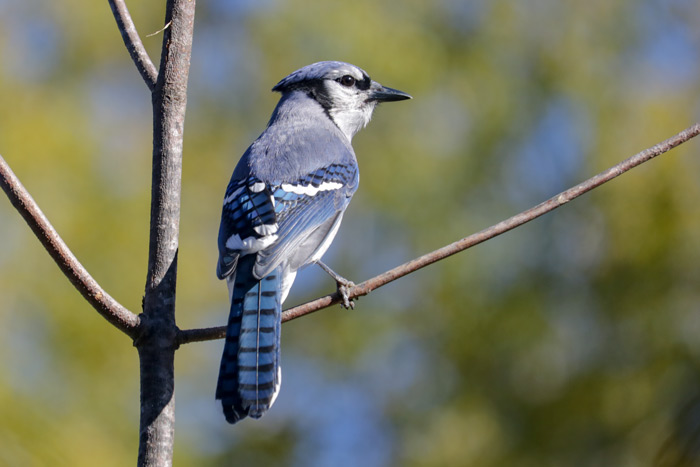
The plumage of the blue jay is a lavender-blue to mid-blue in the crest, back, wings, and tail and its face is white. The underside is off-white and the neck is collared with black that extends to the sides of its head. The primary feathers of the wings and tail are strongly barred with black, sky-bluish, and white spots. The bill, legs, and eyes are all black.
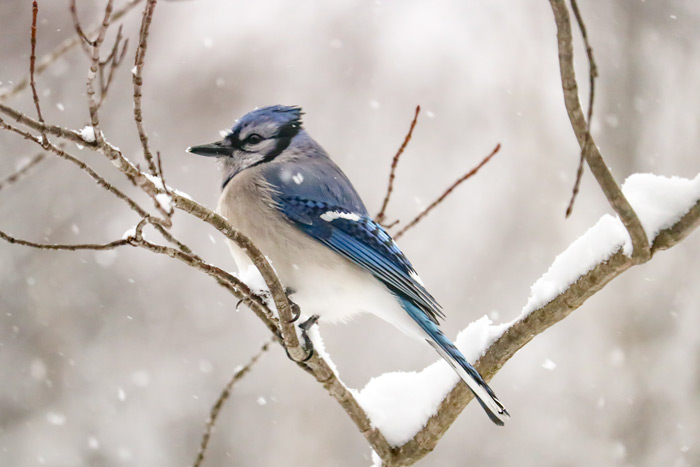
The voice of the blue jay is a harsh slurring jeeah or jay as well as a musical queedle, queedle and many other notes. These birds will frequently mimic the calls of hawks, especially the red-shouldered hawk Buteo lineatu and red-tailed hawk Buteo jamaicensis. These calls are thought to provide information to other blue jays that a hawk is around or may be used to deceive other species of birds into believing a hawk is in the area. These birds can also be very aggressive and territorial. Groups of blue jays often attack intruders and predators.
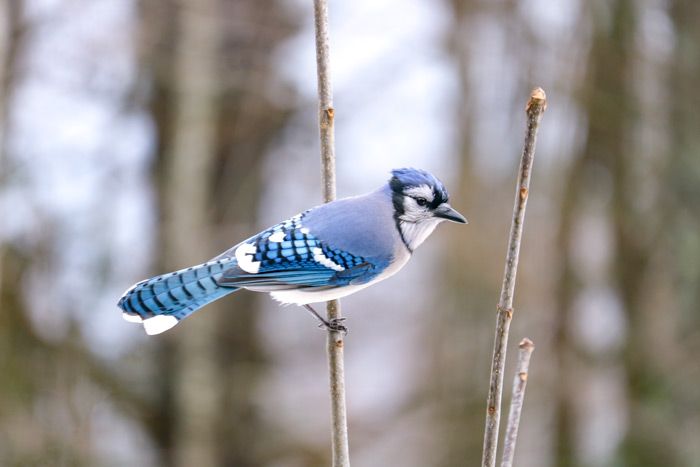
Blue jays can often be observed at the edges of forests. These birds especially like to consume acorns and they are often found near oaks Fagaceae, deciduous forests, and woodlots, as well as towns, cities, and parks.
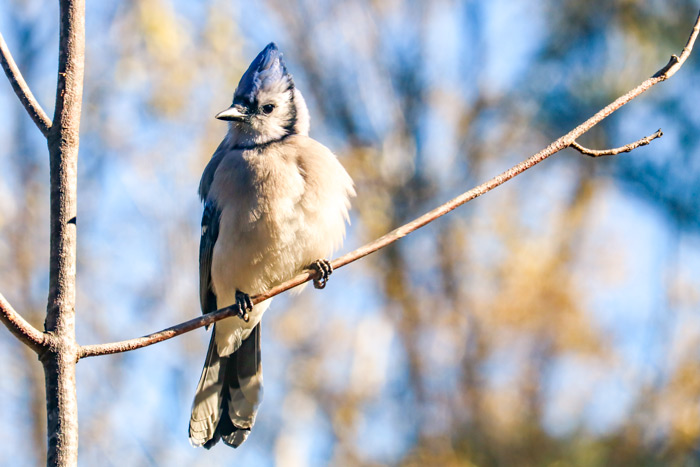
Blue jays are intelligent and adaptable omnivores and may feed on almost anything. These birds eat fruits, acorns, seeds, nuts, insects, mice, and frogs. Sometimes a blue jay will raid the nests of other birds for eggs and young. The blue jay is also a seed spreader. They often bury or hide their food and consume it later. Blue jays also take full advantage of bird feeders. Many bird lovers dislike the presence of blue jays at their feeders. These birds often drive other birds away from bird feeders, but they are usually outranked by other competing birds or animals such as squirrels Sciuridae. Feeder competition can be remedied by adding more feeders and spacing them out.
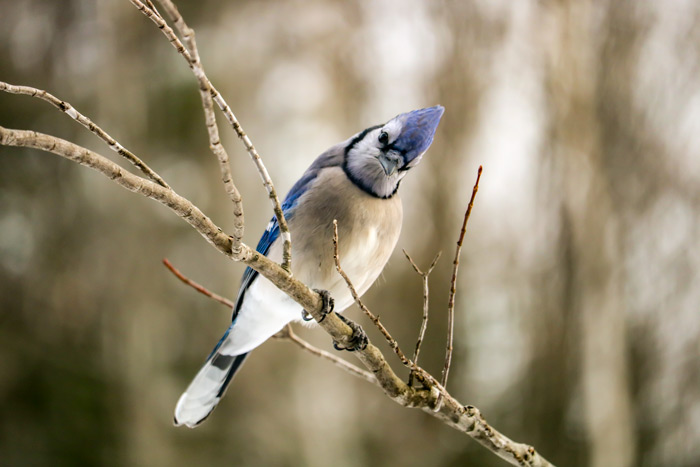
The courtship of the blue jay may involve aerial chases. They often mate for life, remaining with their social mate throughout the year. Blue jays will become quiet and inconspicuous around the nest but will attack with loud calls if the nest is threatened by a predator. Females will lay four to five, sometimes three to seven eggs. They are greenish or buff, sometimes pale blue, spotted with brown and gray. Eggs are incubation is by both parents, for about 16-18 days. Both parents bring food for nestlings. Young leave nest 17-21 days after hatching.
Resources used for this post:
allaboutbirds.org & audubon.org
Leave a Reply